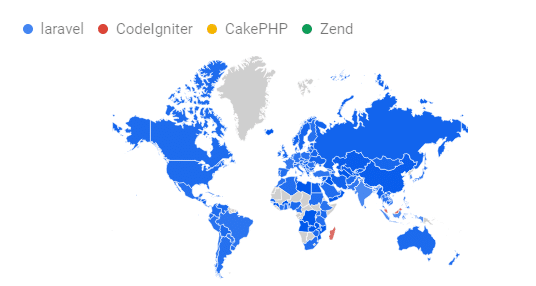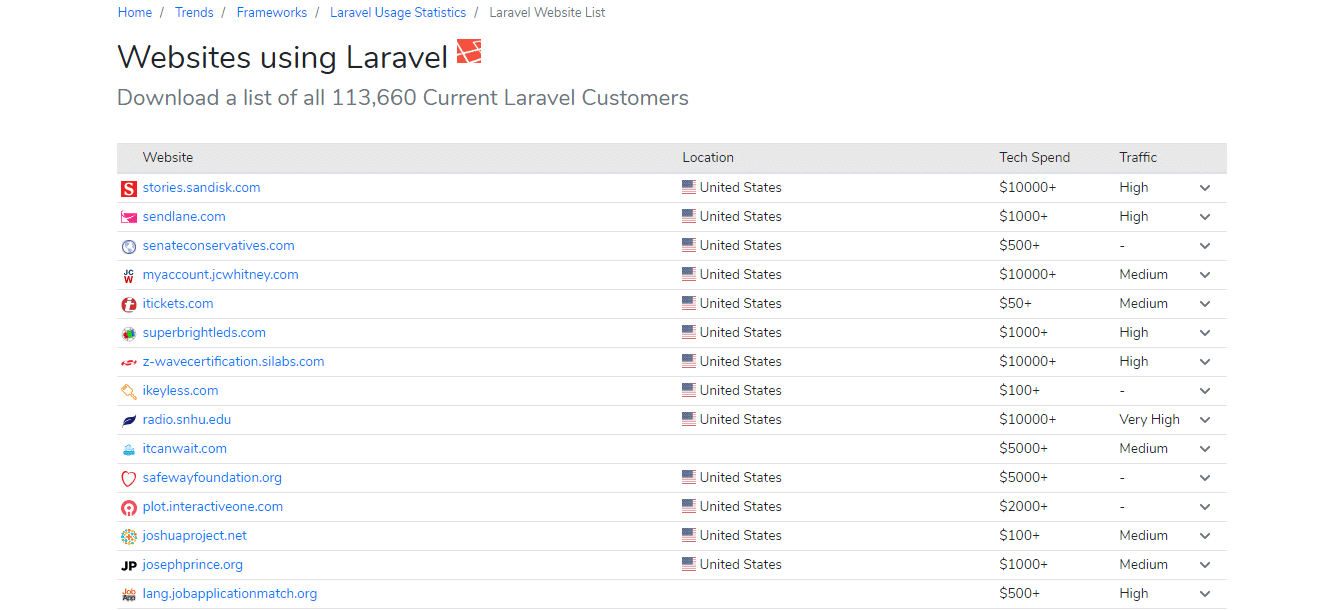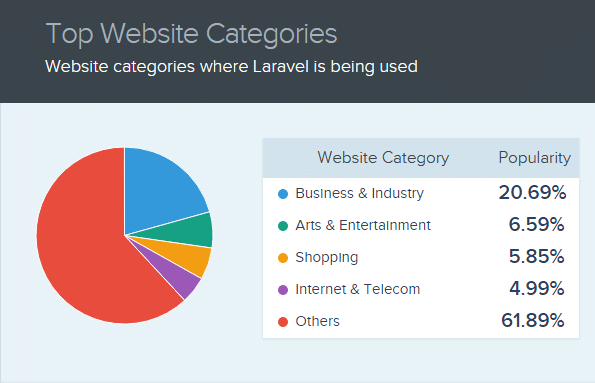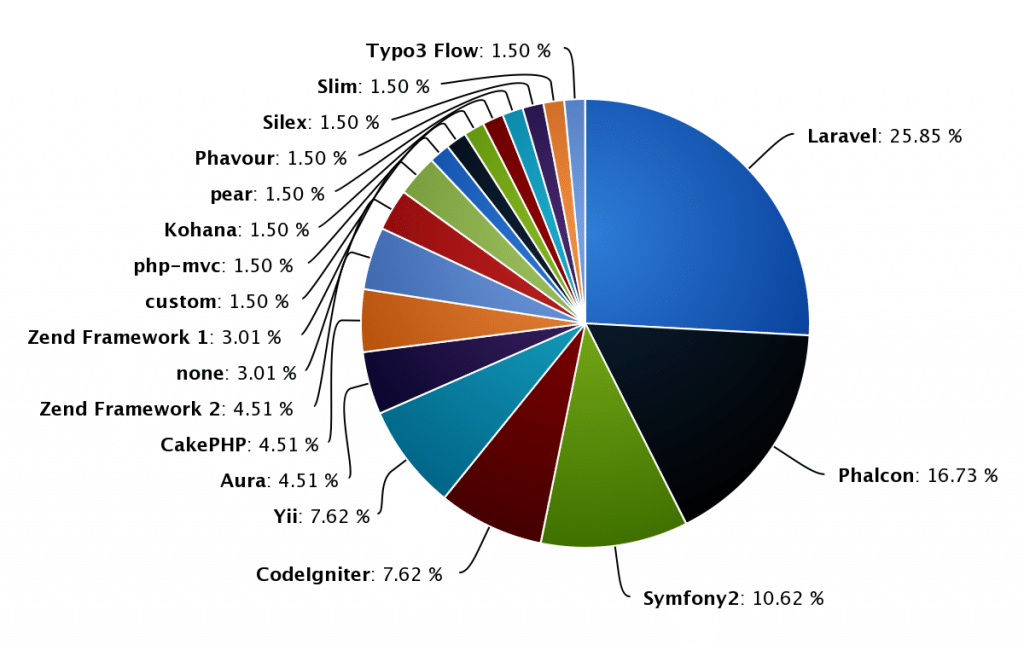Laravel’s introduction in 2011 took the web application developers’ community by storm and how. Posing as an advanced PHP framework alternative to the existing options, Laravel turned many development tasks faster, easier and rewarding. From authentication implementation and error and exception handling to form validation and more, Laravel accomplishes these tasks in minutes and without hundreds of repetitive code lines. Each version of Laravel has successfully unveiled several outstanding features in the past 7 years and the latest Laravel 5.7 version promises even better capabilities than its predecessors.
What Makes Laravel Popular?
To begin with, here are few statistics that speak volumes about Laravel’s current and growing popularity.
- It is the most starred open-source PHP framework on GitHub, with more than 48,180 stars (GitHub).
- The following chart shows how Laravel has the largest market share against other popular PHP frameworks (SlidePlayer).

- Laravel is the most trending PHP framework according to Google Trends:

The above facts and figures are enough to establish Laravel as web application developers’ favourite. Now, let’s find out some of the most amazing benefits that Laravel offers to enjoy this level of popularity:
- User authentication and authorization is no more an issue, thanks to the built-in support that Laravel offers.
- Using Memcached and other cache backends Laravel facilitates faster web applications than before.
- Laravel is counted among the most secure web application development platform as it offers protection against SQL injections, cross-site scripting and other threats.
- Artisan, one of the most well-known built-in tools of Laravel, helps developers to create their own commands, create database structures, generate basic MVC files etc.
- Laravel supports object-relational mapping (ORM) which eliminates the need to write SQL codes. As a result, the framework becomes faster than its counterparts as database interactions are accomplished quickly.
- Unit testing is another remarkable feature of Laravel using which the developers are able to conduct multiple tests and ensure application’s stability.
Database migrations, Blade templating engine, object-oriented libraries and many other amazing features establish Laravel as an unbeatable PHP development framework.
Growing Laravel Usage Worldwide
If we take a look at the geographical distribution of Google search results for various PHP frameworks, we get a clear picture:

There are many websites built in Laravel that have managed to achieve high ranks on Google and other popular search engines. Not only are these websites praised for their user-friendliness, but they also are admired for receiving high traffic volumes. Some of them, as mentioned by BuiltWith Trends, include:

According to the BuiltWith Trends, there are 1,077,555 websites (including the historical ones) that use Laravel. Out of them, there are 103,177 live websites across the world using the framework. The trends get even more interesting as they reveal that:
- About 83% of the top 10k sites use Laravel against only 18% of them using WebMatrix.
- Laravel is the top web app technology in the top 100k sites category with about 92% using the framework.
- It is the most popular framework in the web app category in the countries like United States, China, Spain and Netherlands.
Going further, website owners in different categories prefer to hire laravel developer for web app development. Some of the top categories include (SimilarTech):

Laravel Improving with Every Version
- The very first version Laravel 1 came up with built-in support for models, sessions, routing, localisation, authentication and several other features that most of the existing frameworks lacked.
- Laravel version 2 supported controllers and became an MVC-compliant PHP framework.
- Command line interface, added support for database management systems, database migrations, even handling and several other prominent features accompanied the version 3.
- Laravel 4 impressed with features like Composer, database seeding, soft deletion, support for different emails etc.
- Laravel 5 improved further and brought along Flysystem, Schedulers and more.
What’s Hot with Laravel 5.7?
Keeping up the tradition, Laravel 5.7, released in August 2018, promises more features and better performance than its predecessors. Find out how.
- Laravel Nova: Laravel developers now have access to a refined and modern admin dashboard or panel called Nova. It promises CRUD interface for Eloquent models which helps the developers to administer the fundamental database records with ease. Moreover, it also offers support for custom filters, custom metrics and lenses. One can also generate custom fields and build custom tools using the panel. Queued actions, improved authorization support and scout search integration are some of the other Nova capabilities the version boasts of.
- Email Verification: Laravel 5.7 introduced this new feature that prompts the users newly registered with the web app to verify their emails. It allows sending a signed verification link to the new users. When the users click the links, this feature records the verification time in the database and directs the users to the locations that you specify. An additional feature is the verified middleware which allows only the verified users through the designated routes.
- Symfony Dump Server: Laravel 5.7 introduced a new package called Symfony Dump Server which allows dumping data to an HTML file or console and not to the browser. It allows error debugging in the web app much simpler and faster as it won’t hamper the app runtime. In this way, the call outputs no more interfere with the API/HTML responses and allow neat app functioning.
- Improved Pagination Links Customization: With its latest version, Laravel provides control to the admin for customizing the number of links on either side of the paginator. Earlier, the primary paginator links could display up to three links on each side. With this new feature, customize this number to display a number of links on each side.
- Notification Localization: With the previous Laravel versions, the notifications were sent only in the current languages. The new version permits setting up a locale or desired language. It means that the web app would change into the set locale while the notification is being formatted and get back to the previous one once it is done. You can also localize multiple notification entries using this feature.
- Guest User Gate/Policies: In the versions prior to Laravel 5.7, only the authorized users were allowed to access the web app. Whenever an unauthorized user would try the access, he or she would be denied the permission. The new gates or policies of the latest version don’t completely deny the access, but allow the unauthorized users to access the app as guests. It allows the administrator to decide and control the action authorization and maintain the app’s accessibility.
- Error Messages Improved: It was indeed frustrating to receive a cryptic or confusing error message in response to the dynamic calls made to the Eloquent models. The new version changes this forever. Rather than displaying the cryptic error messages, it would now show clearer message so that error detection becomes easier and faster.
- Resources Directory Changes: The structure of the resources directory has changed for good. Rather than accommodating an assets folder, the directory can be flattened for better viewing and near referring.
- Other Useful Features: Laravel 5.7 supports callable array syntax as well (rather than only strings, supported by the previous versions). It also supports console testing which allows mocking user inputs for the console commands. There is also improvement in how the Artisan command would be written and tested.
By disclosing each of the above improvements, features and packages, Laravel 5.7 surely adds to the fondness it enjoys with the growing community of developers.
Upgrading to Laravel 5.7
Upgrading to the latest version of Laravel definitely adds to the advantage of running a high-performing web app. If you wish to upgrade from Laravel 5.6 to 5.7, you won’t need to have a new PHP version. The upgrade can be done using the PHP version 7.1.3 as both Laravel versions use the same PHP version. If you still use Laravel 5.4 or 5.5, you would require the PHP versions 5.6.4 and 7.0.0 respectively for the upgrade.
Hiring a laravel development company helps in a seamless upgrade to the latest version by ensuring the backup, making sure all the modules are functional and finally deploying the website with minimal downtime. If you are developing a new web app, an expert laravel developer can help you build the app using Laravel 5.7. Some of the advantages of hiring a Laravel expert include:
- Customized web app development to create an absolutely unique design
- Small to big scale Laravel development or upgrading using the best tools and features
- Robust restful solutions and development of special app extensions like e-commerce payment and more
- Complete support and maintenance and assurance of future upgrades to the newer versions



